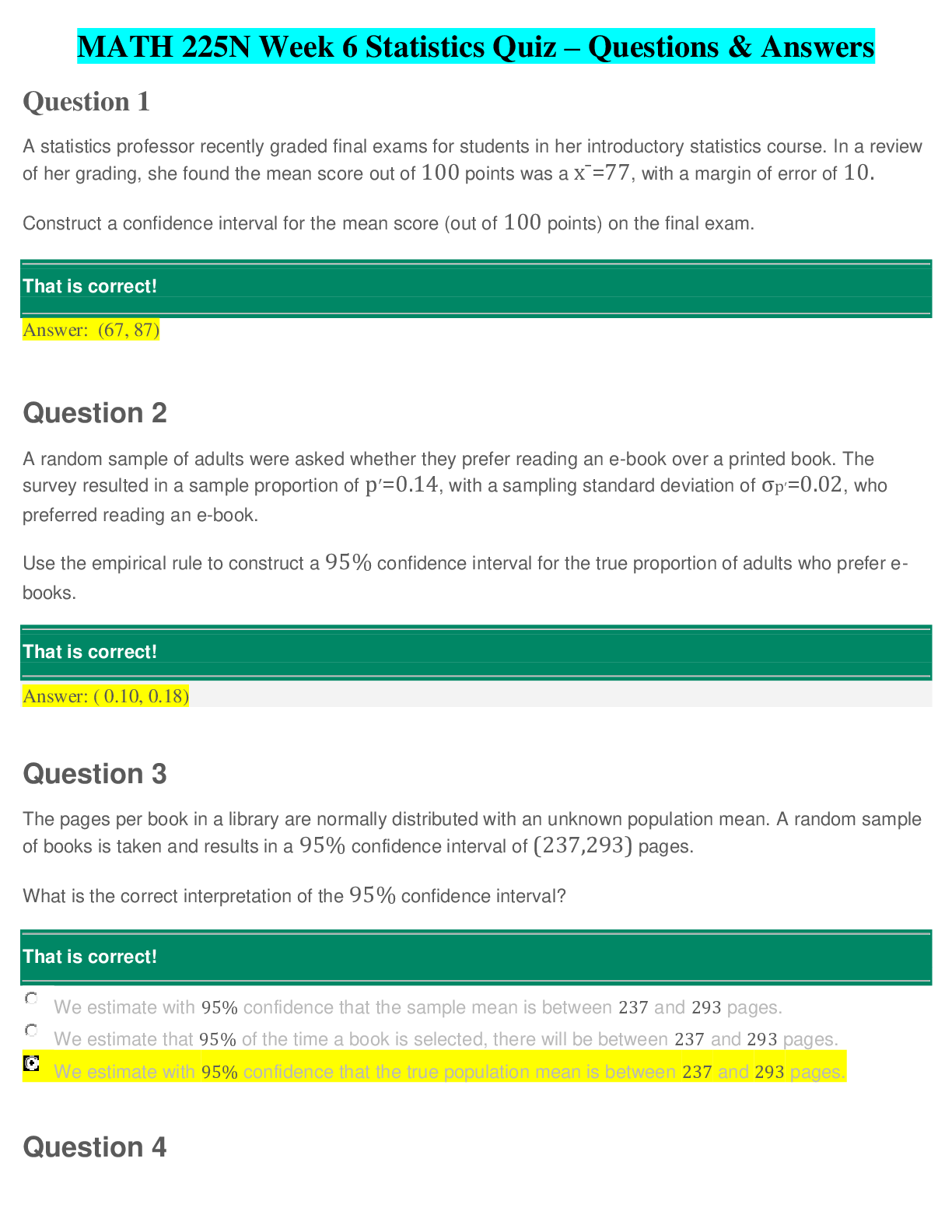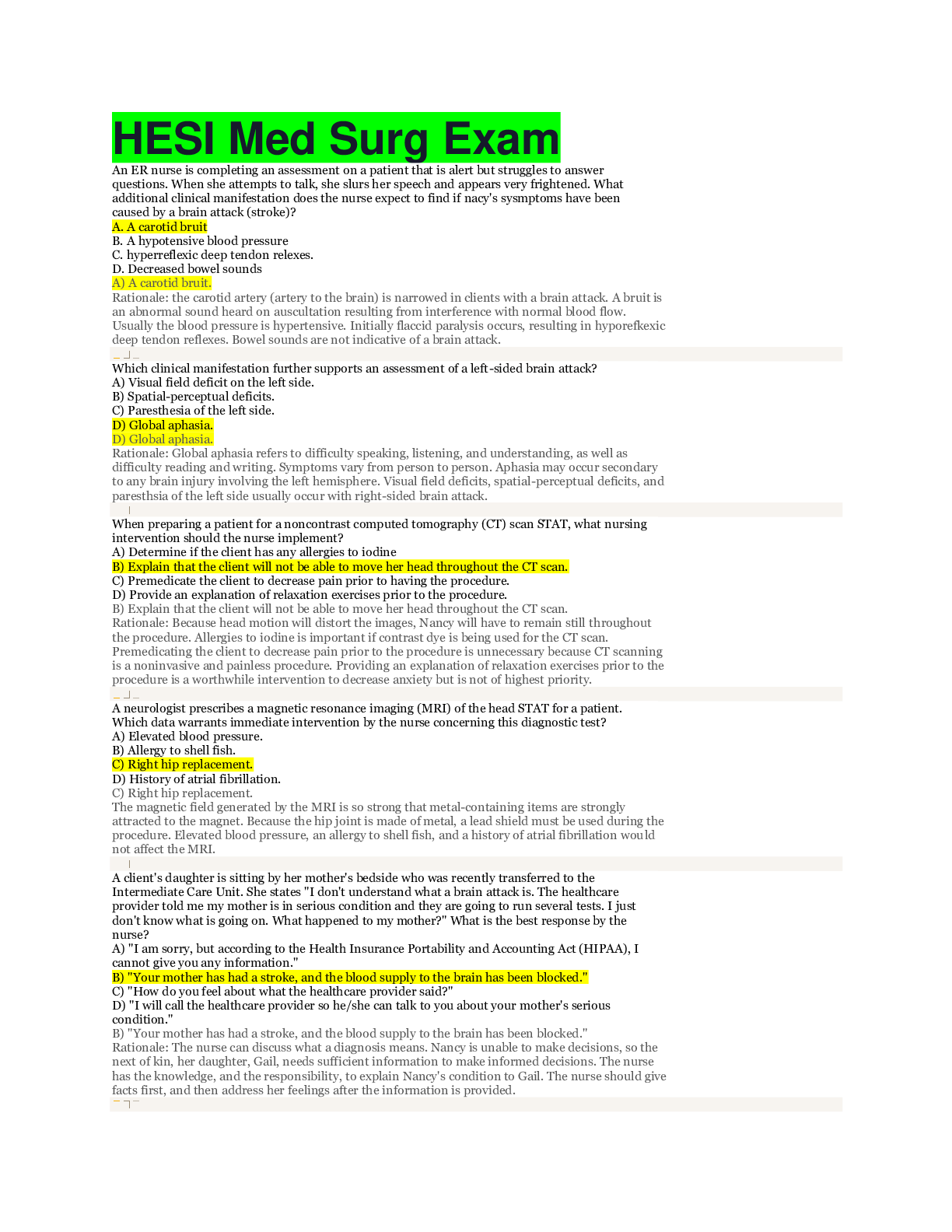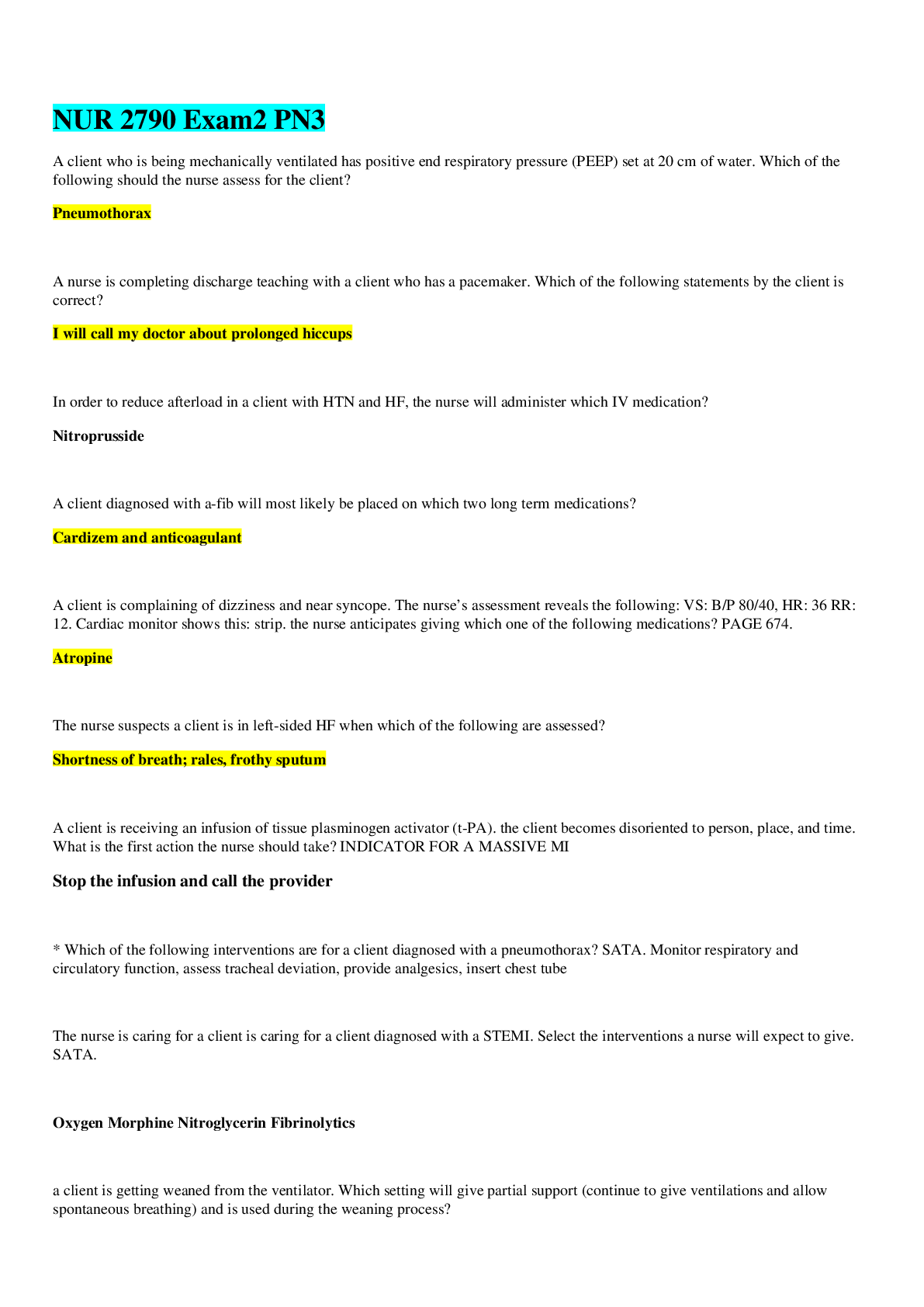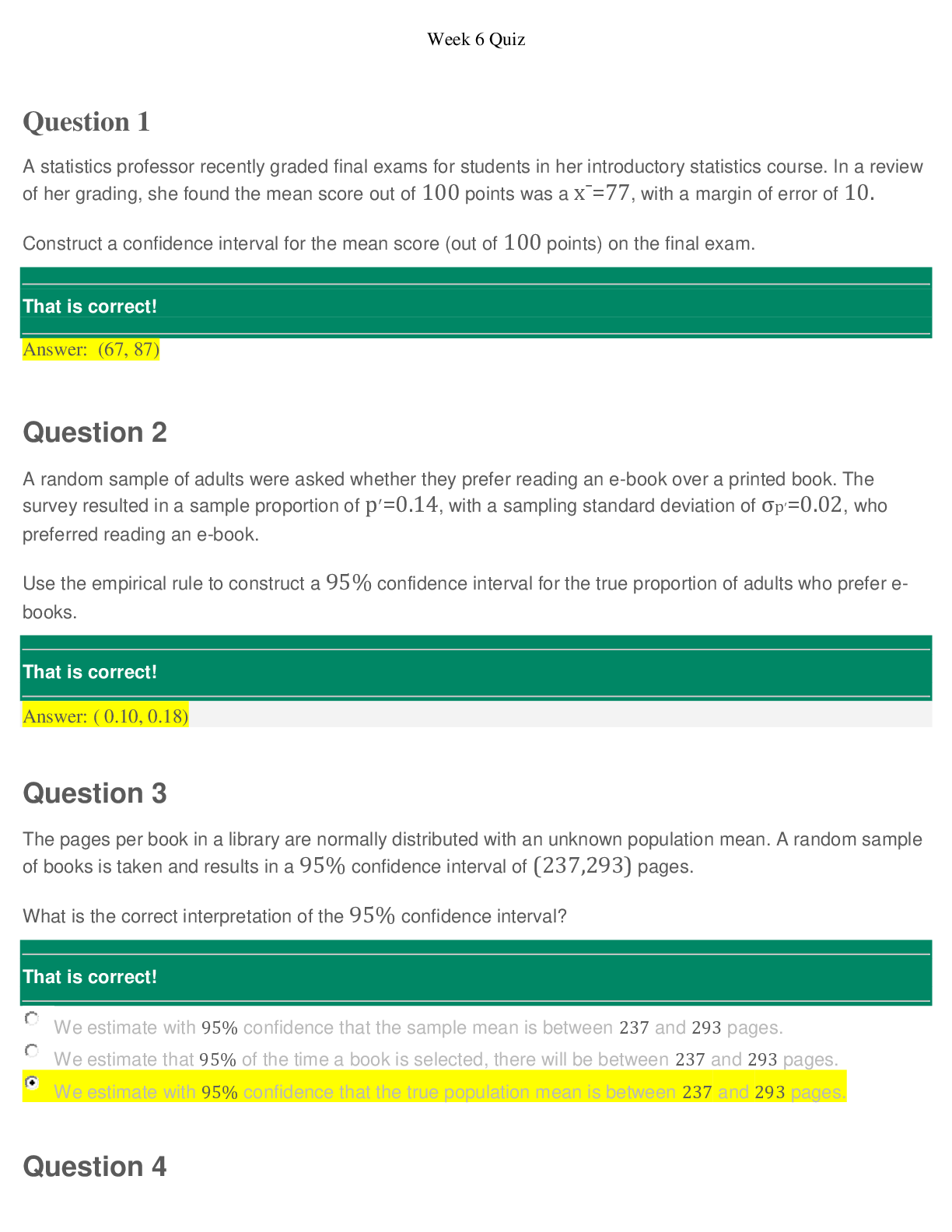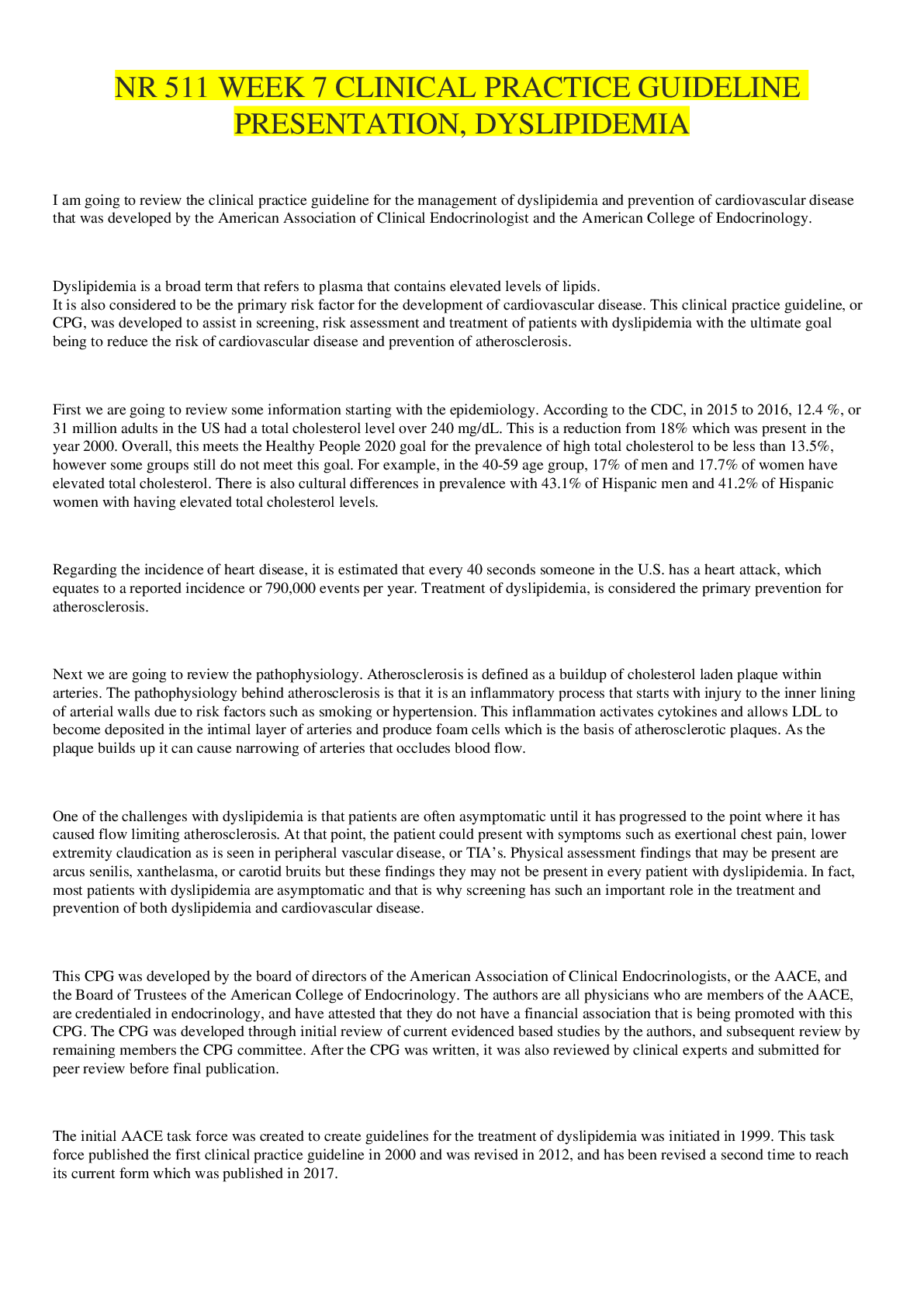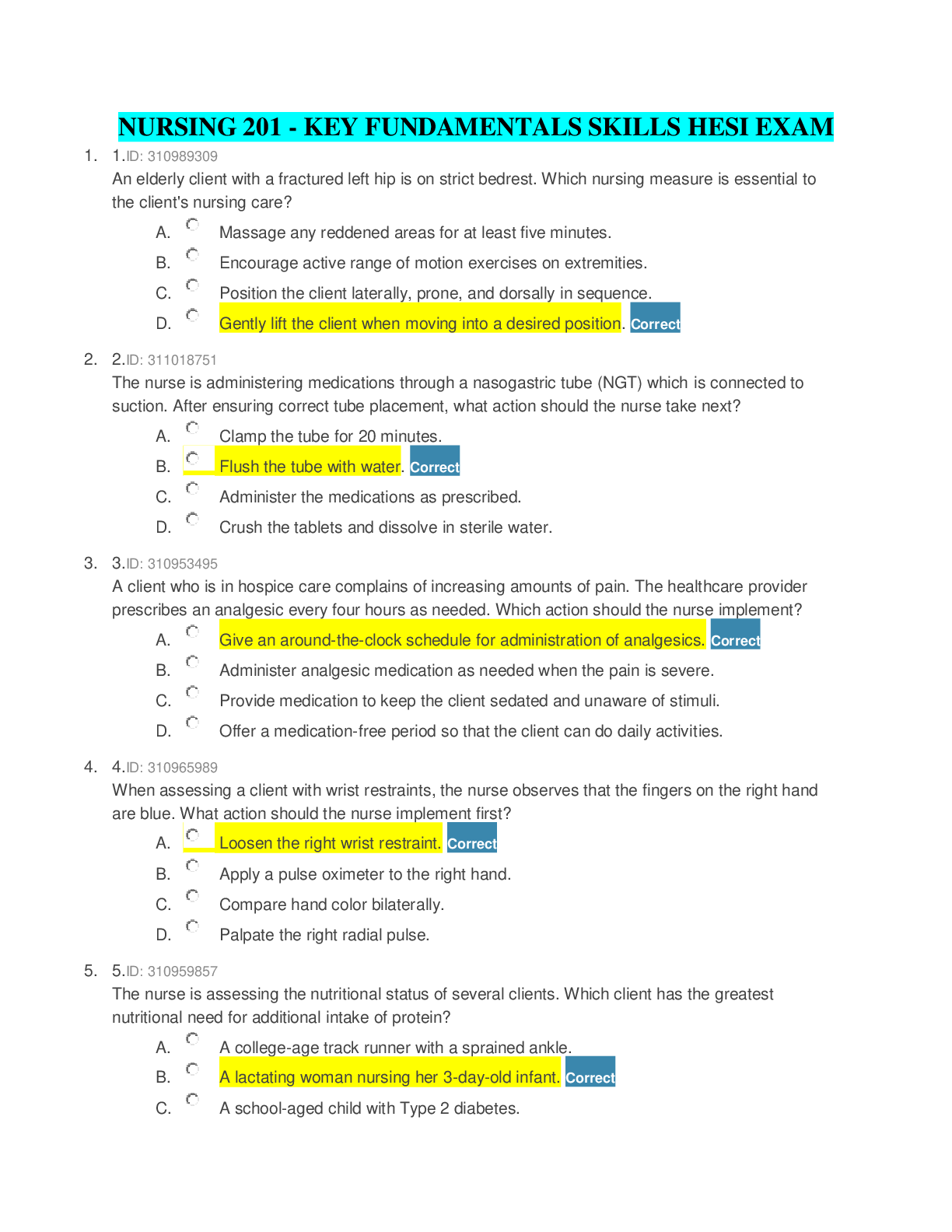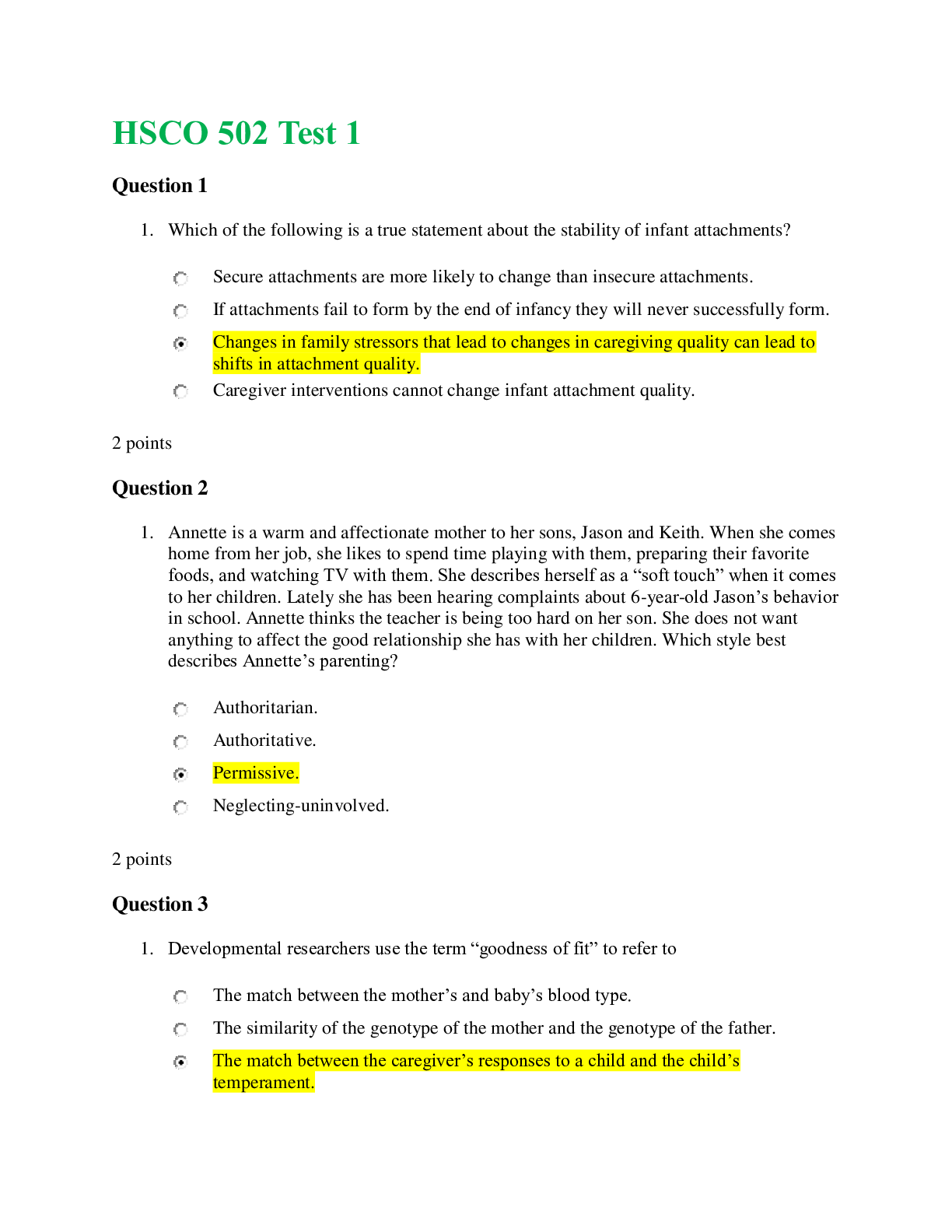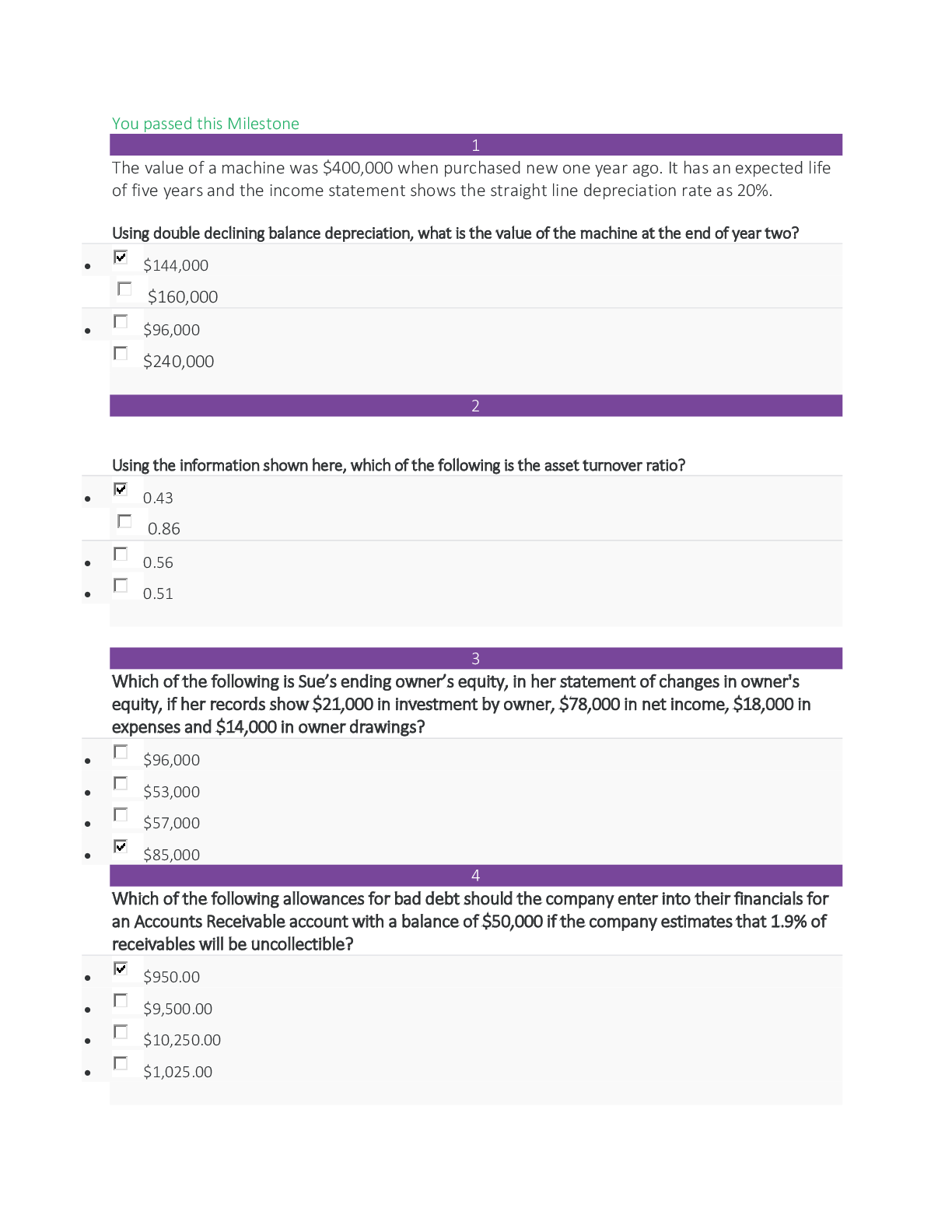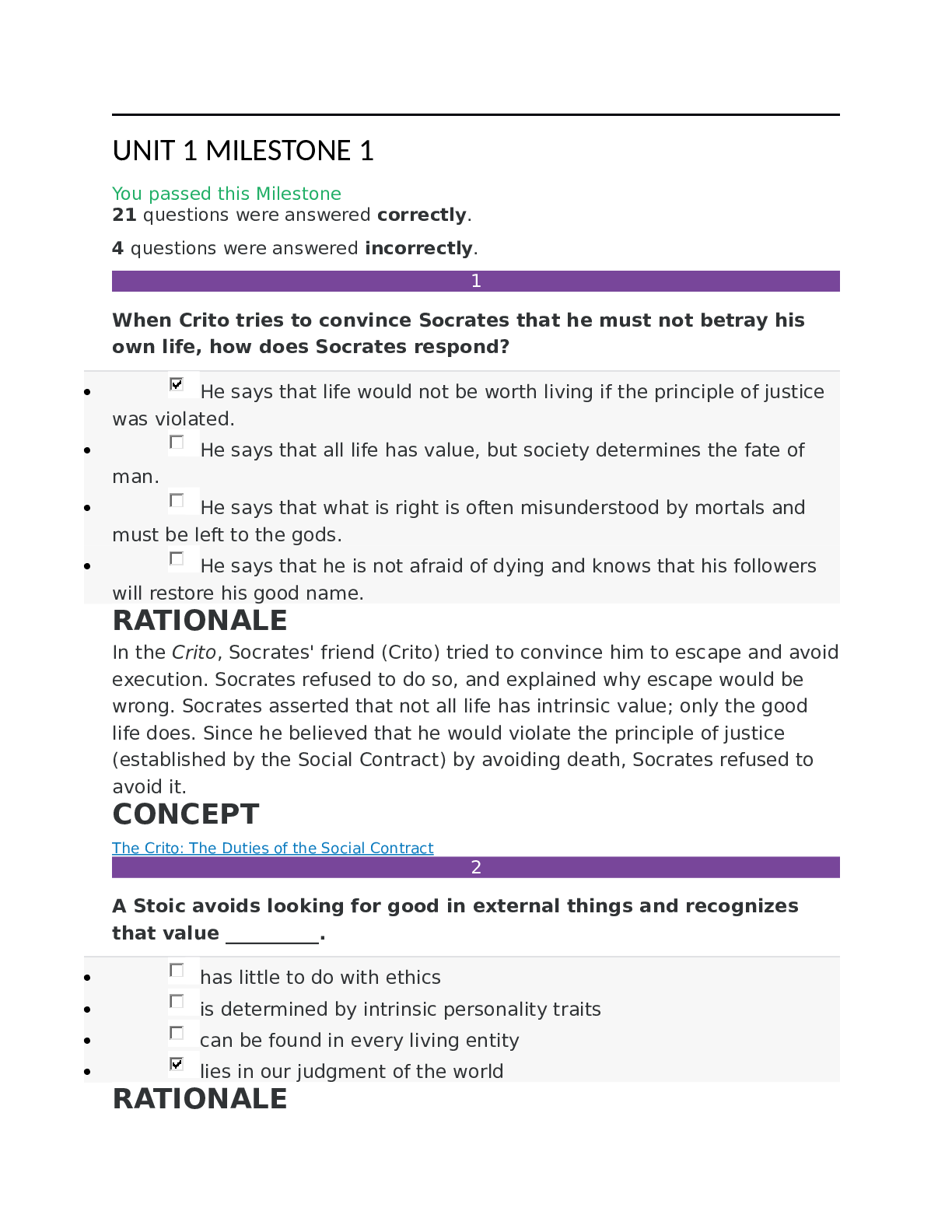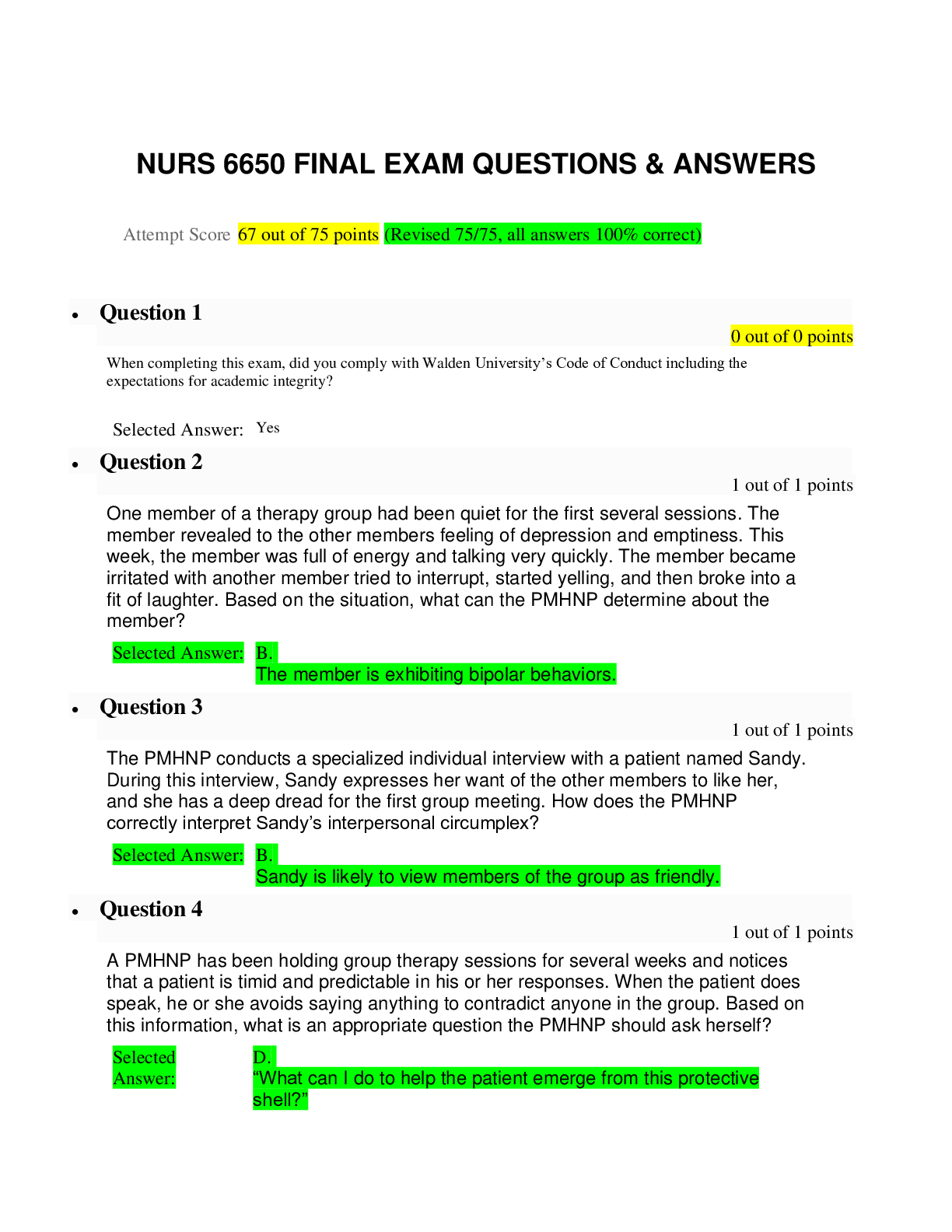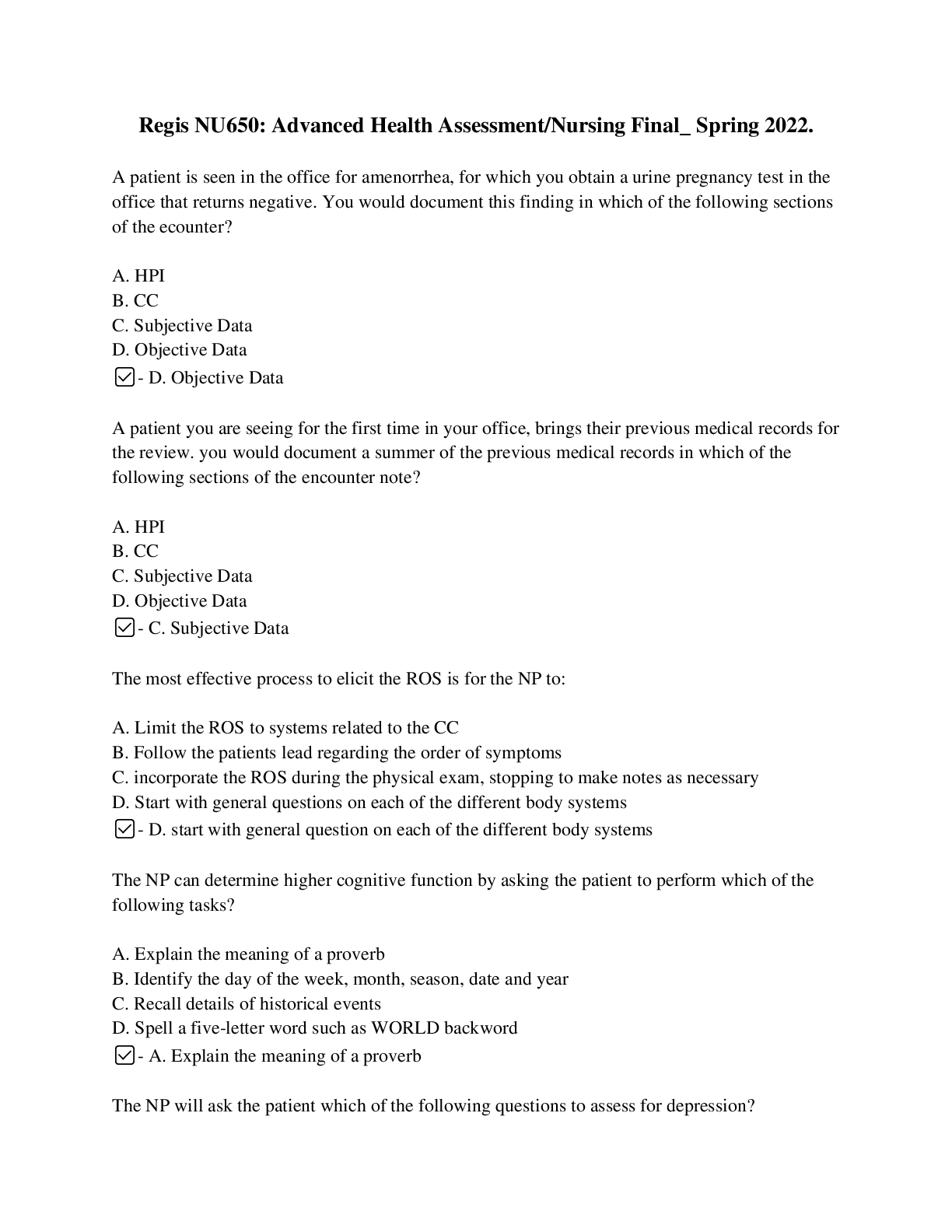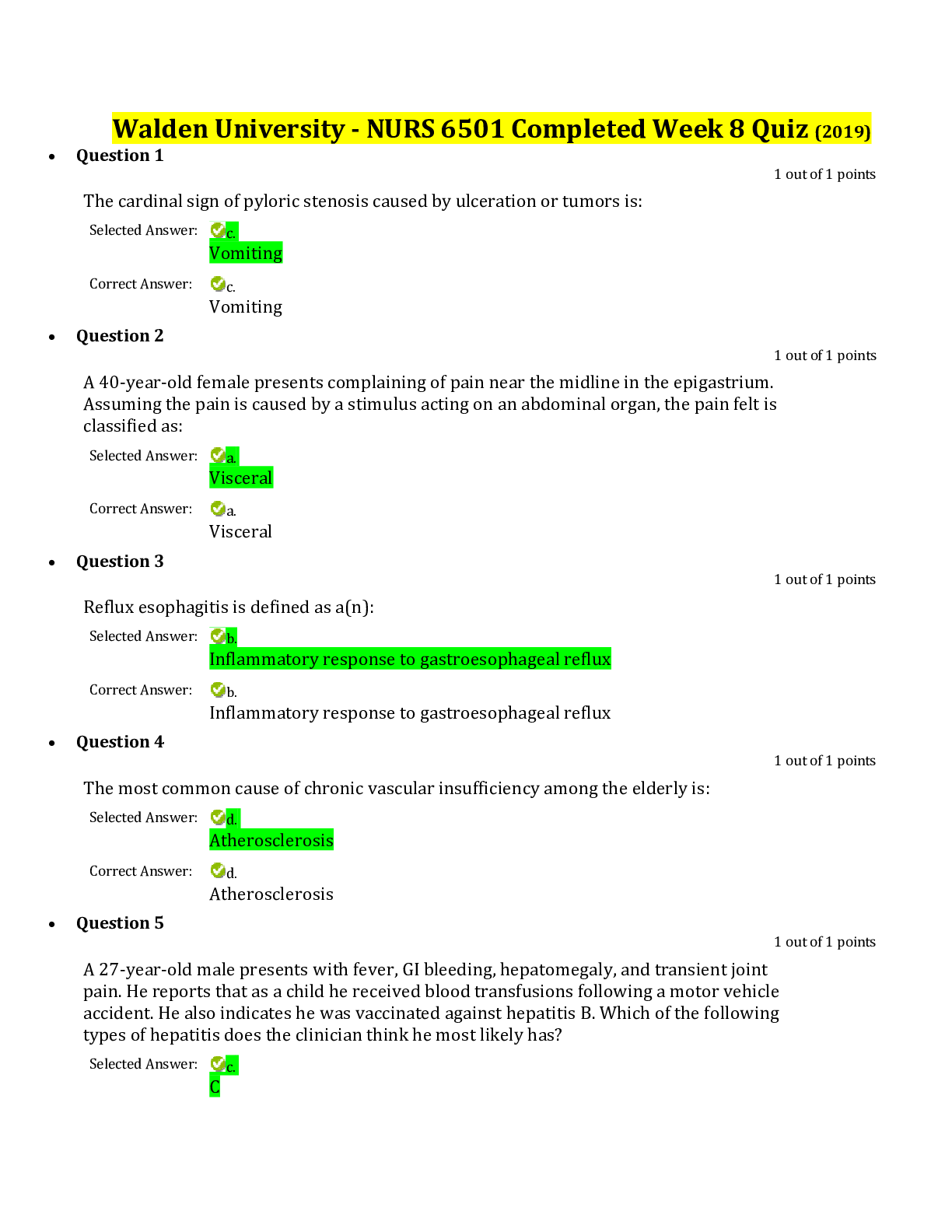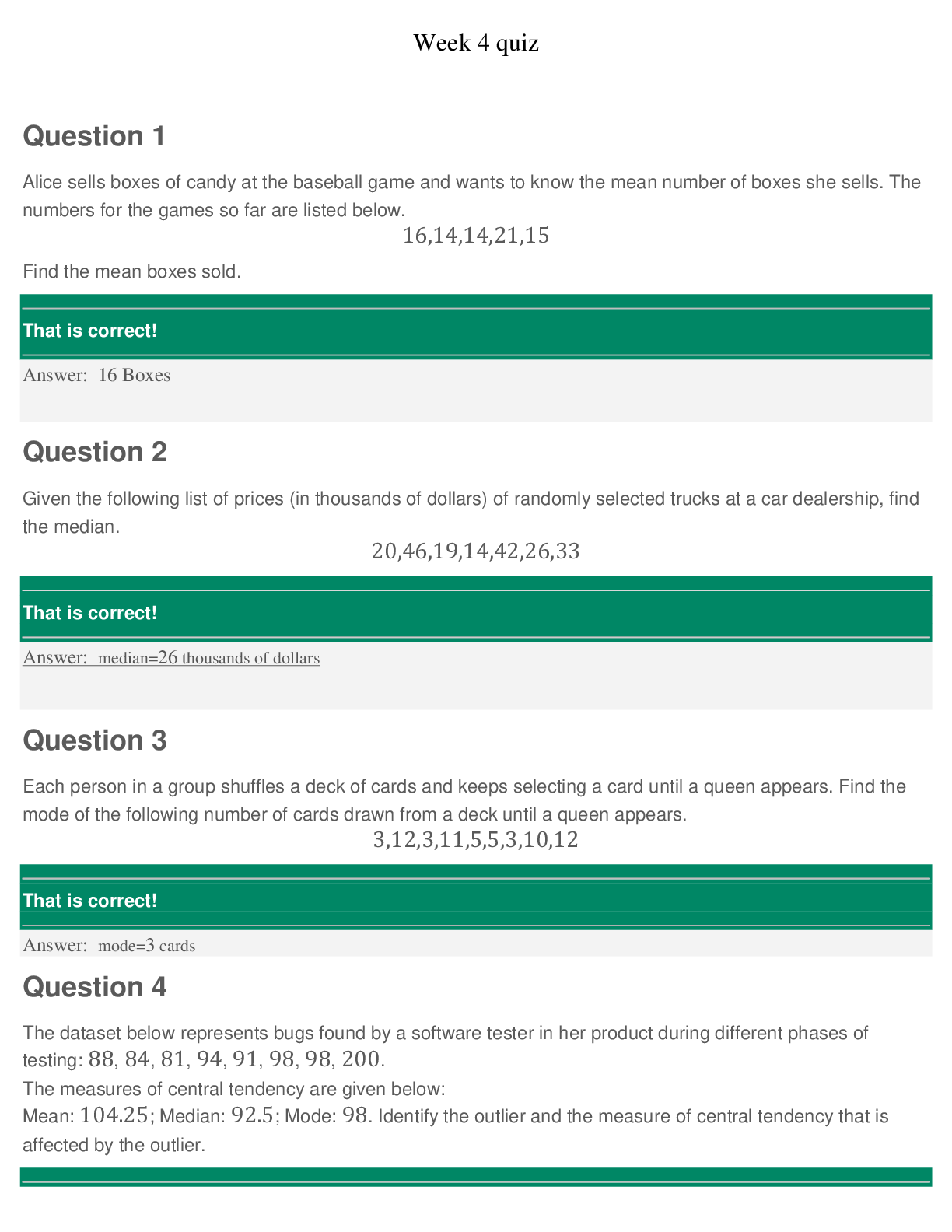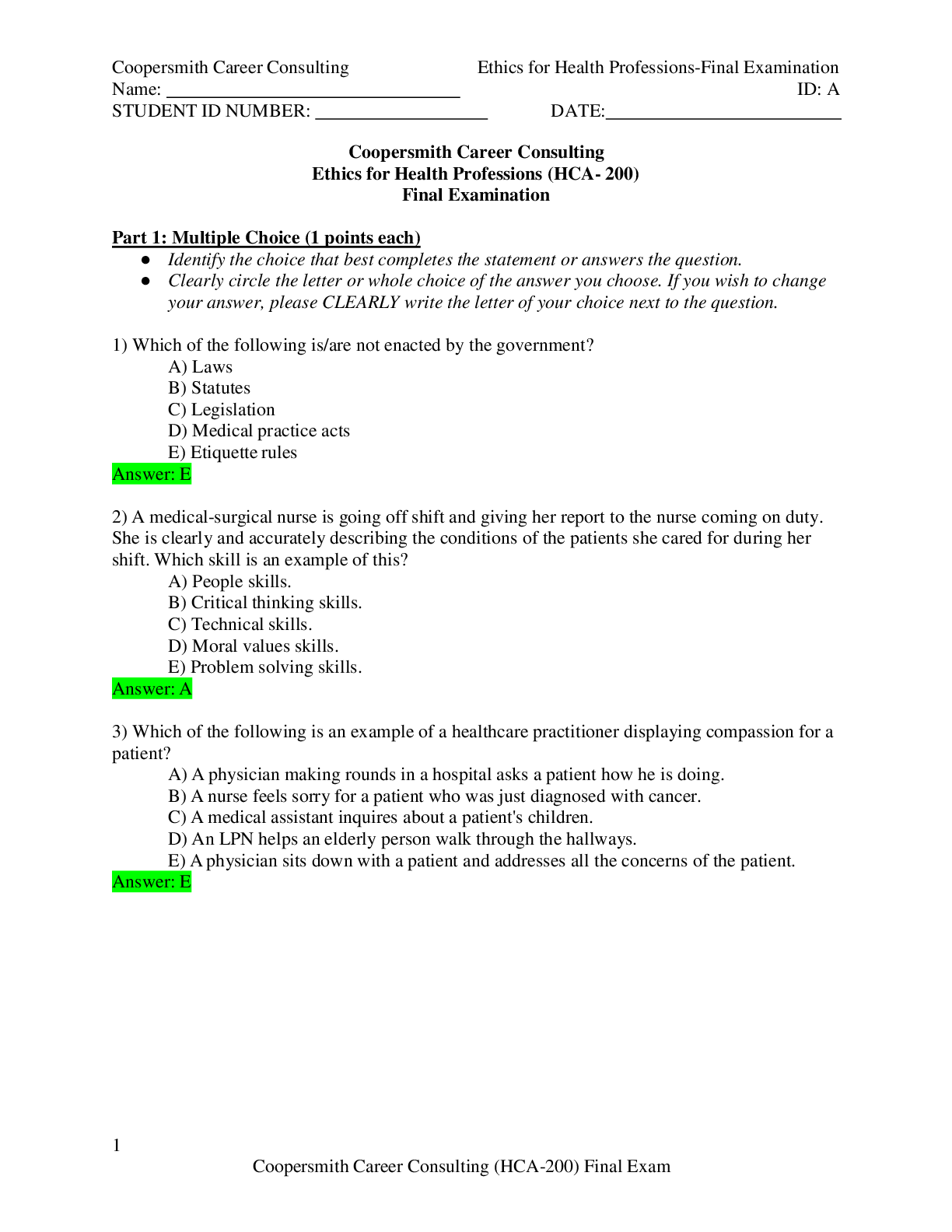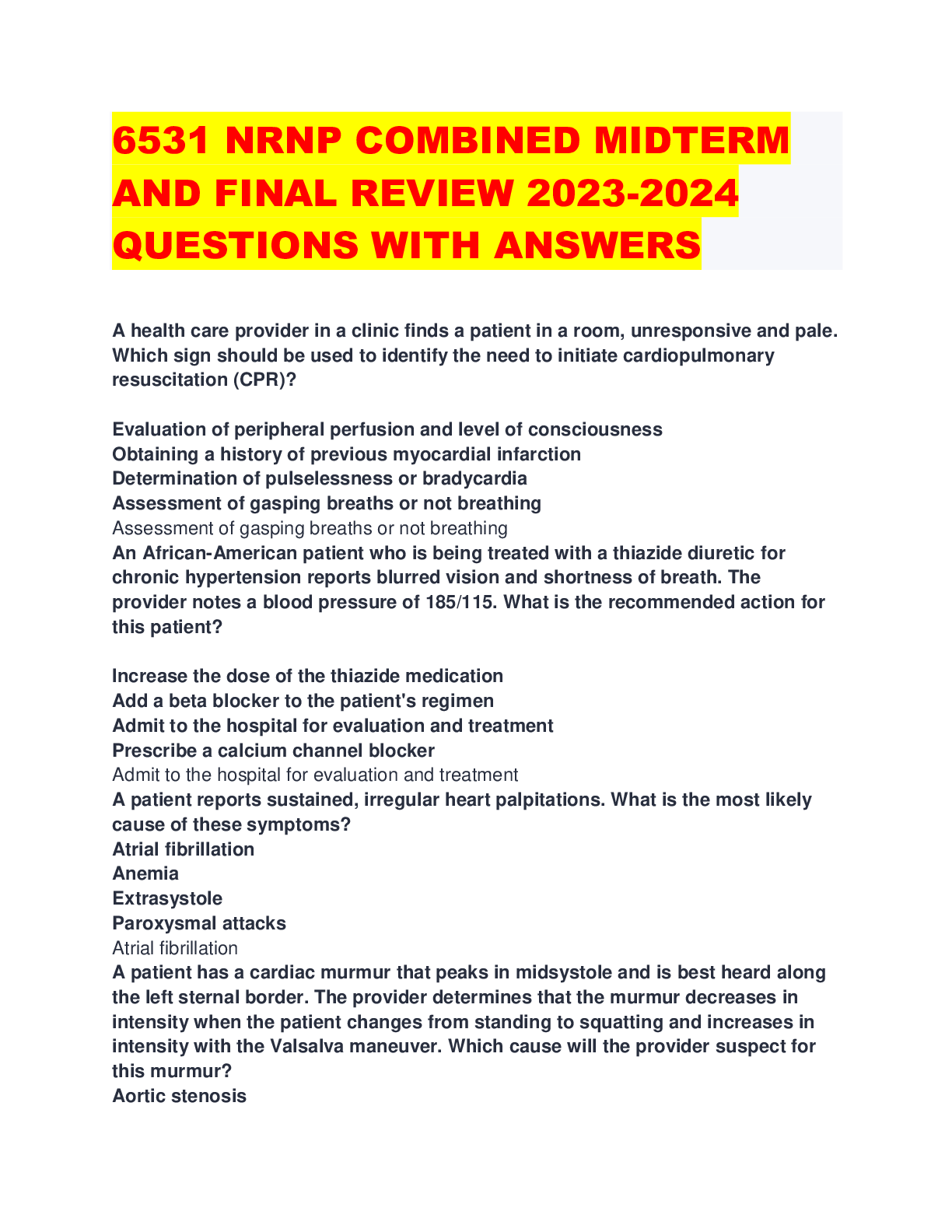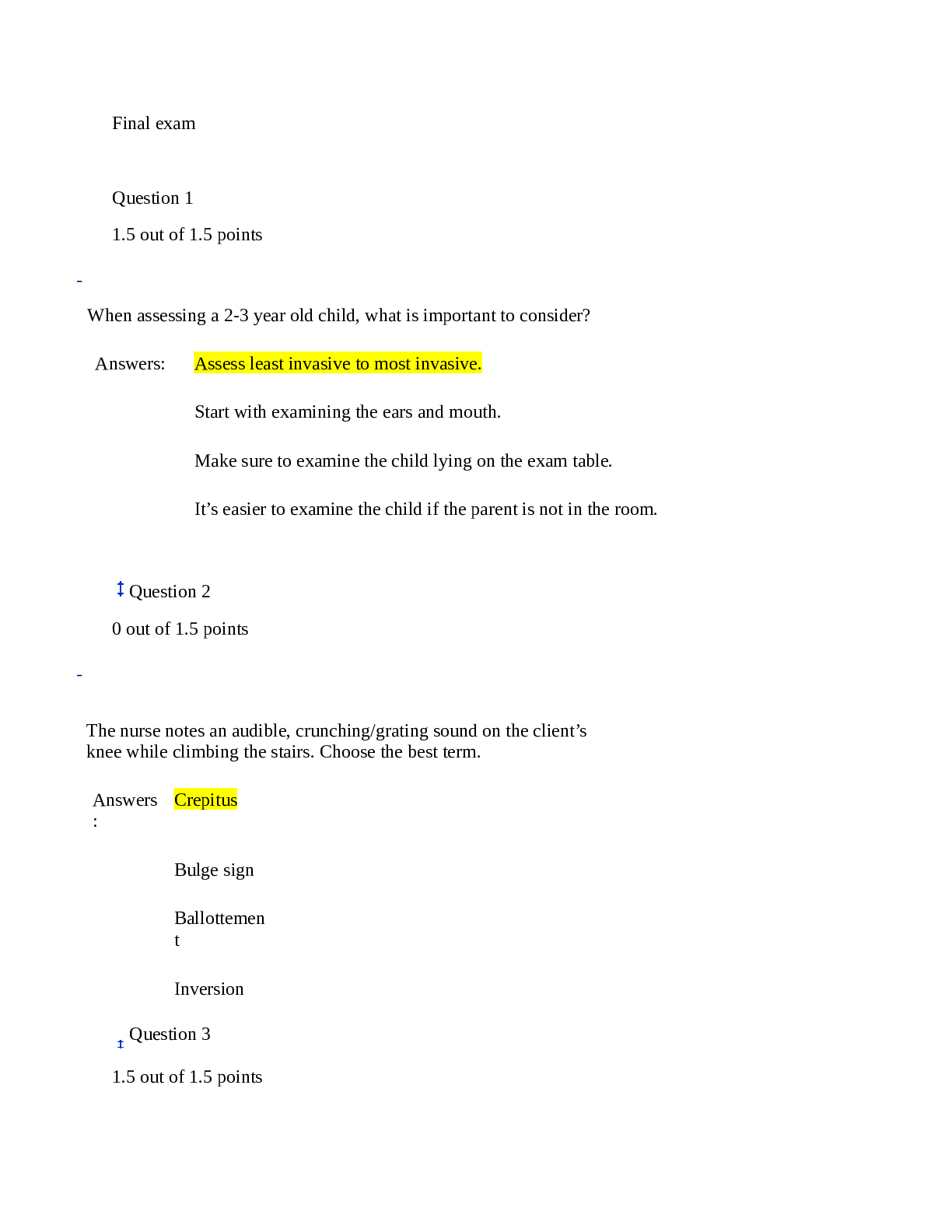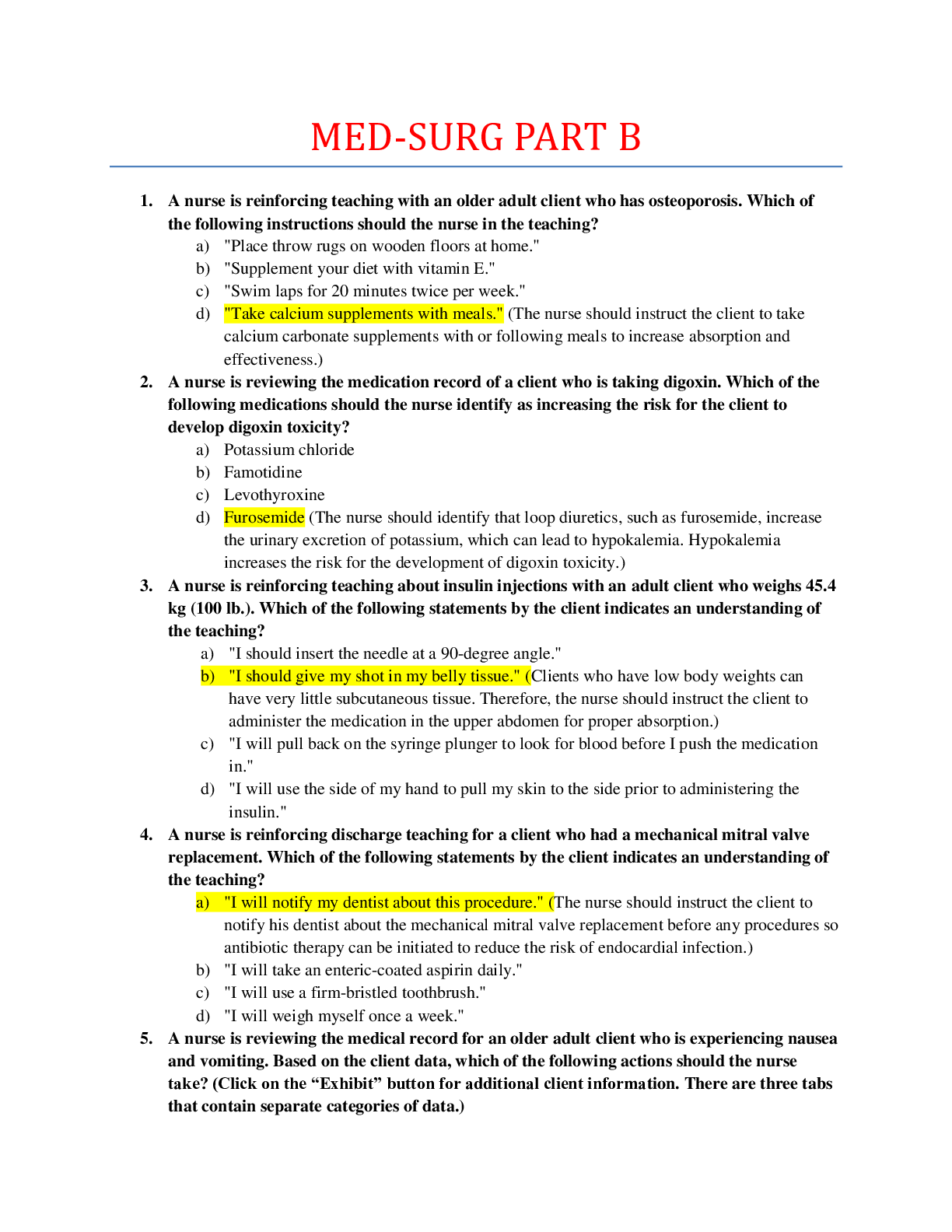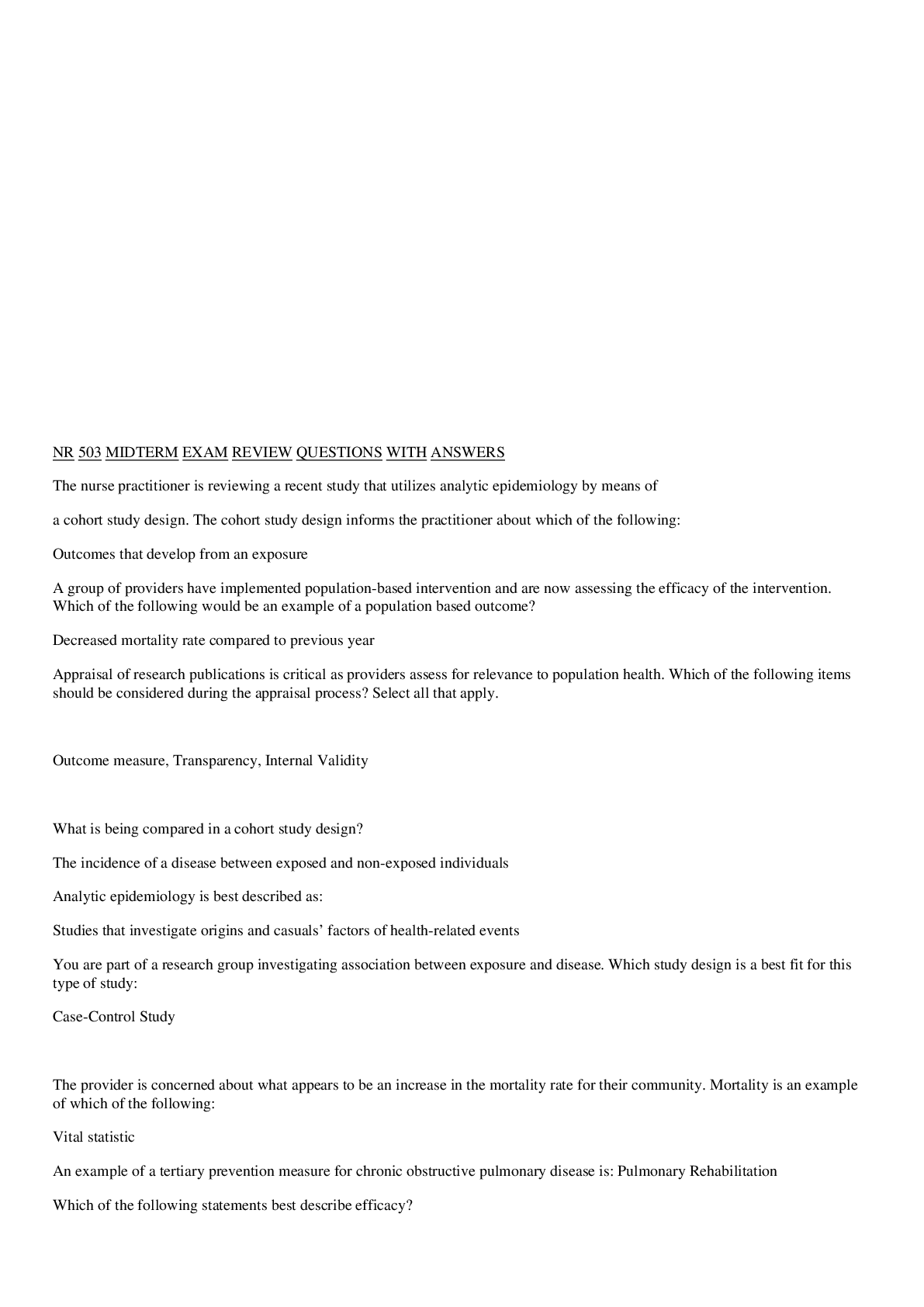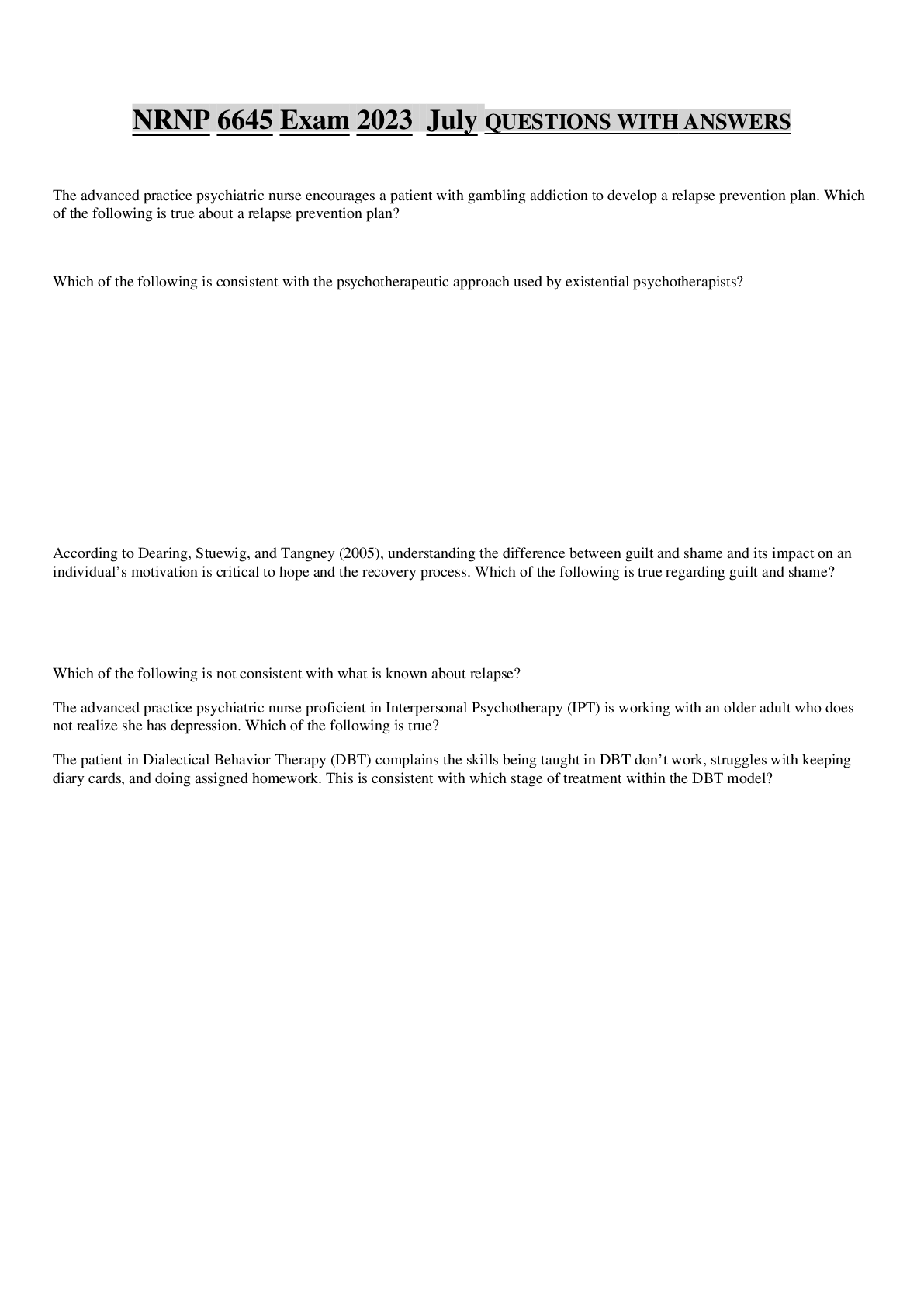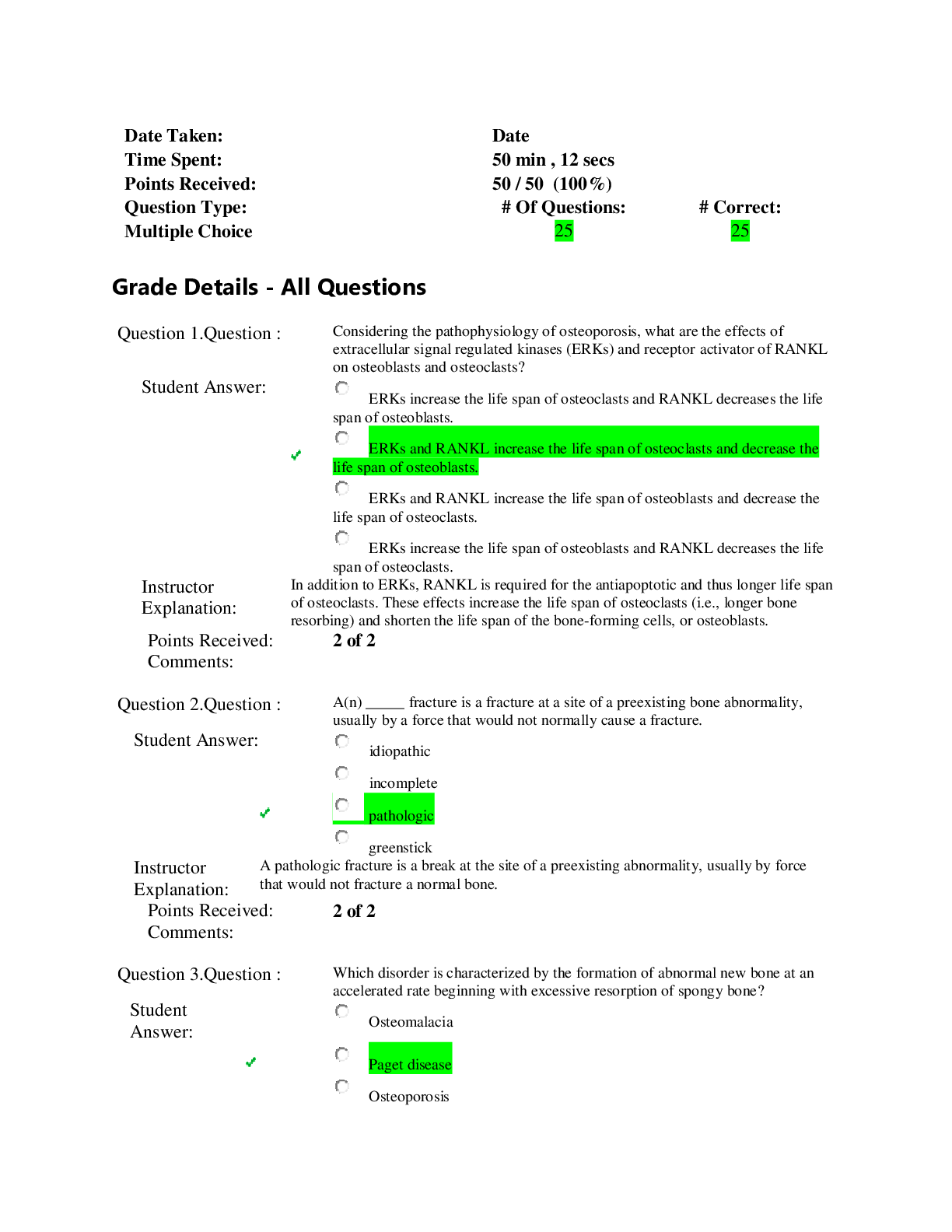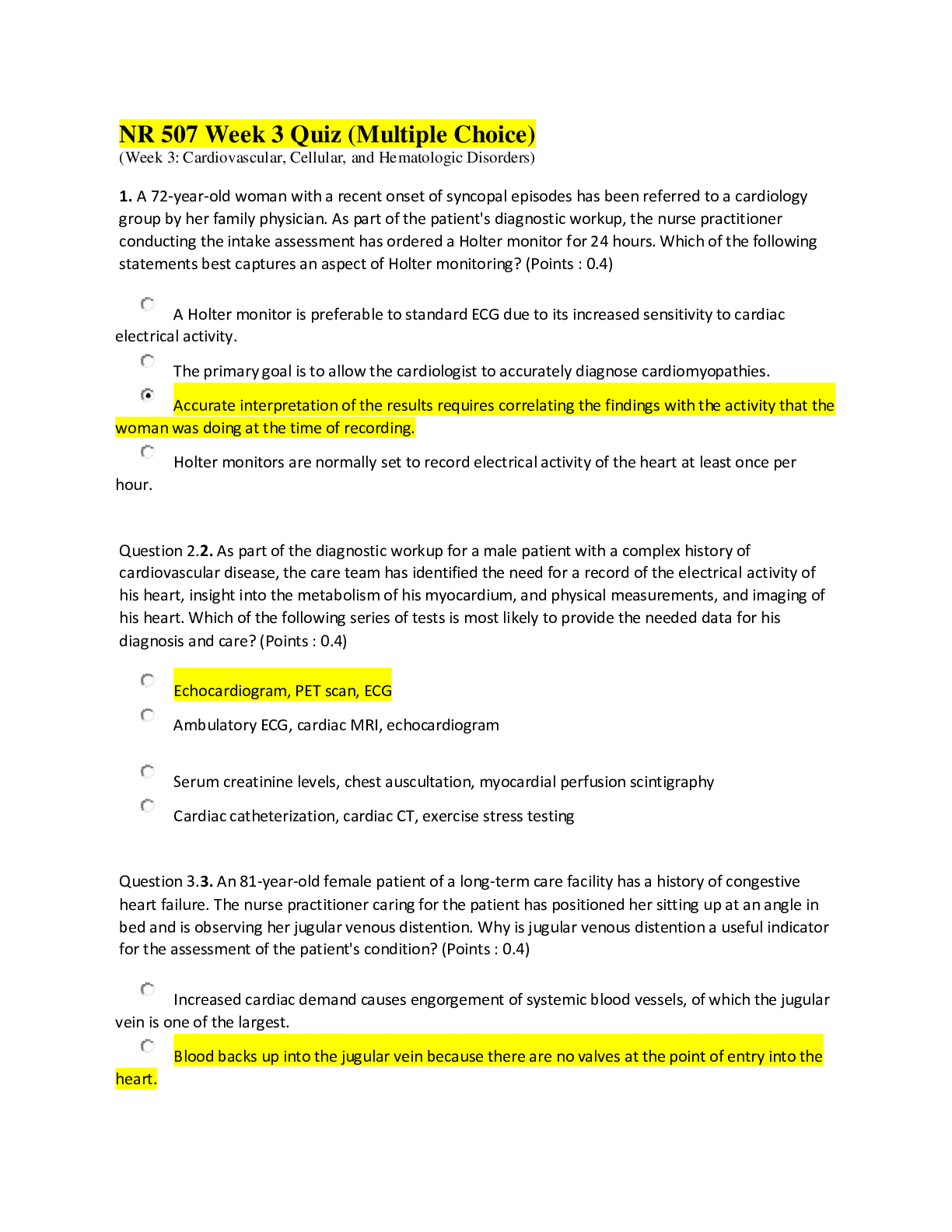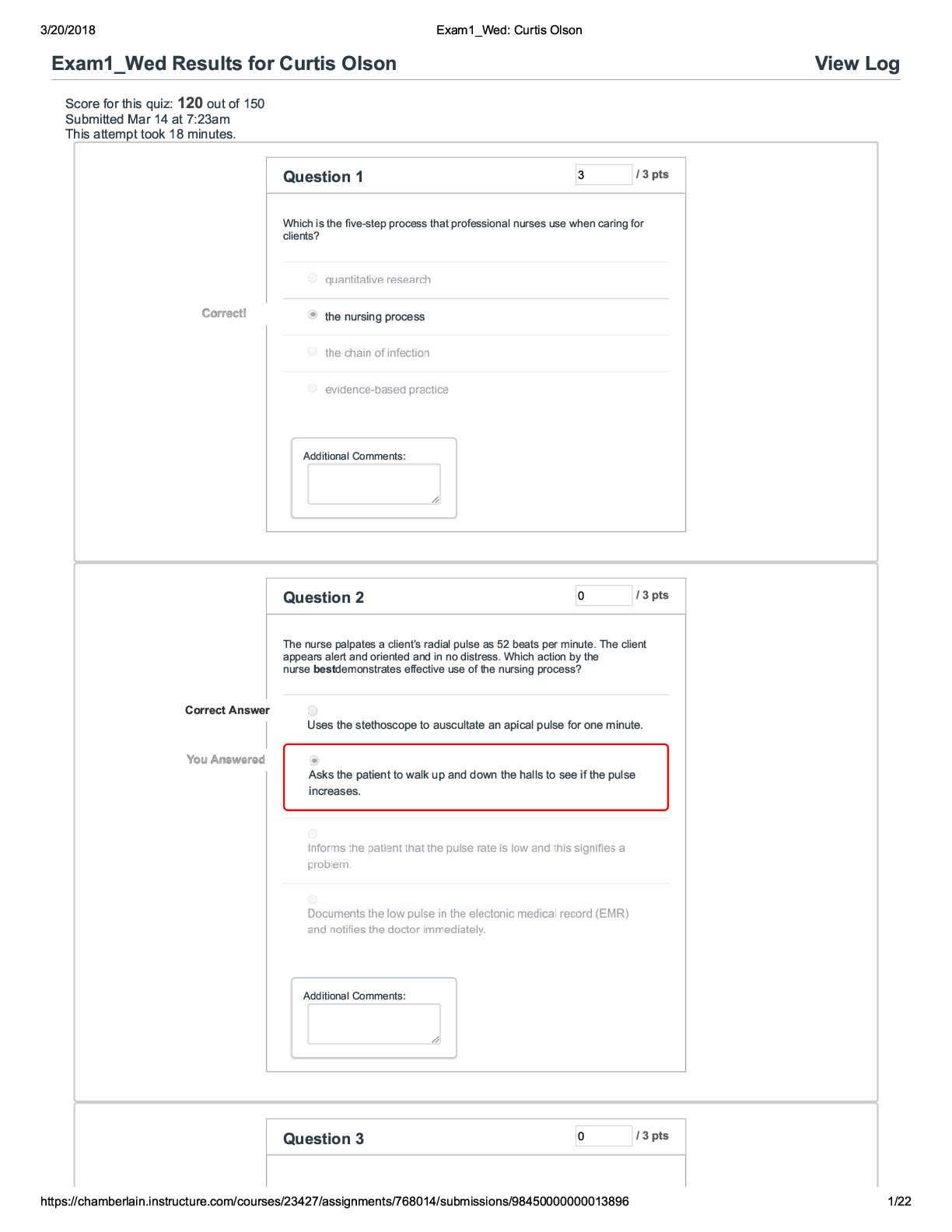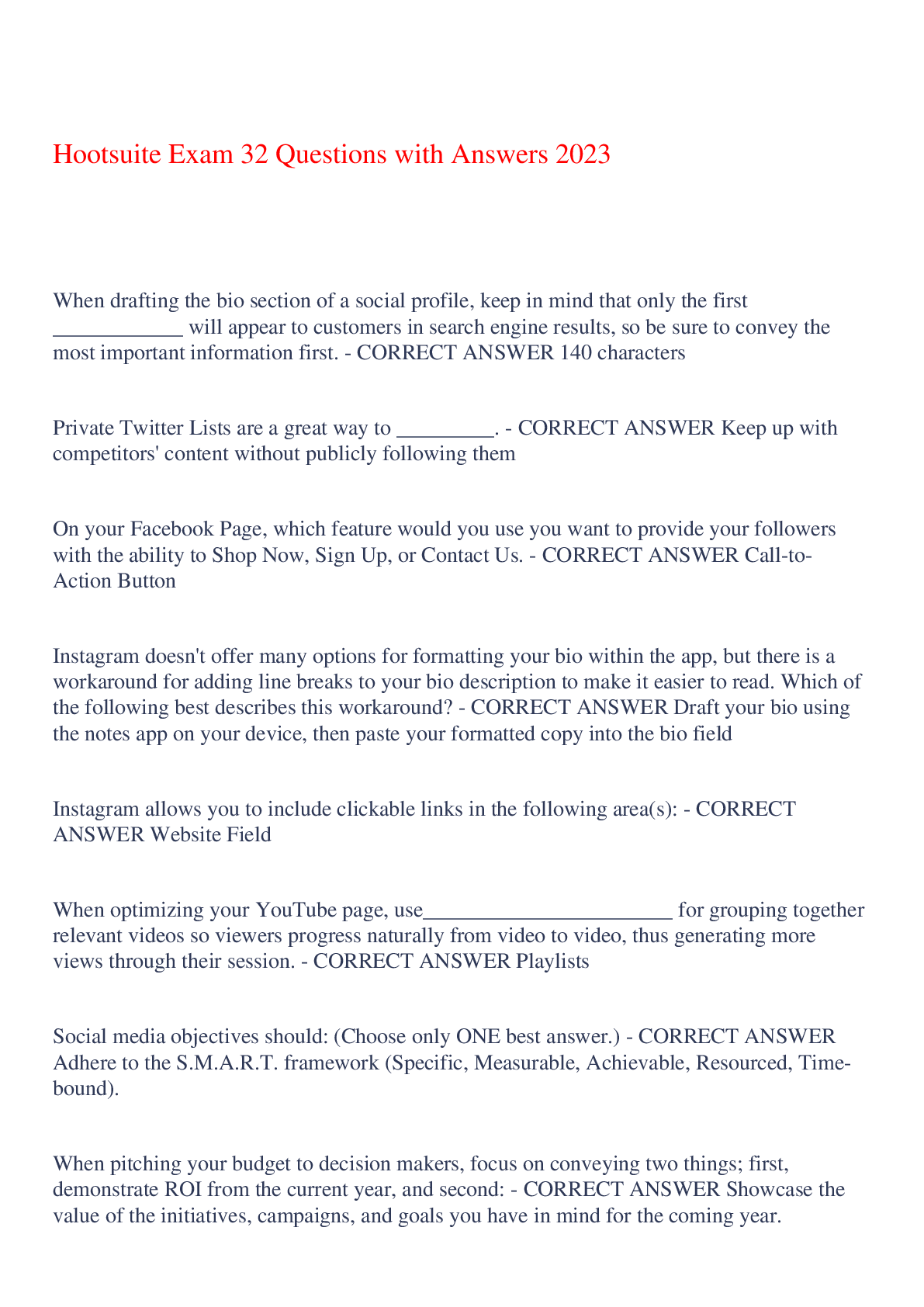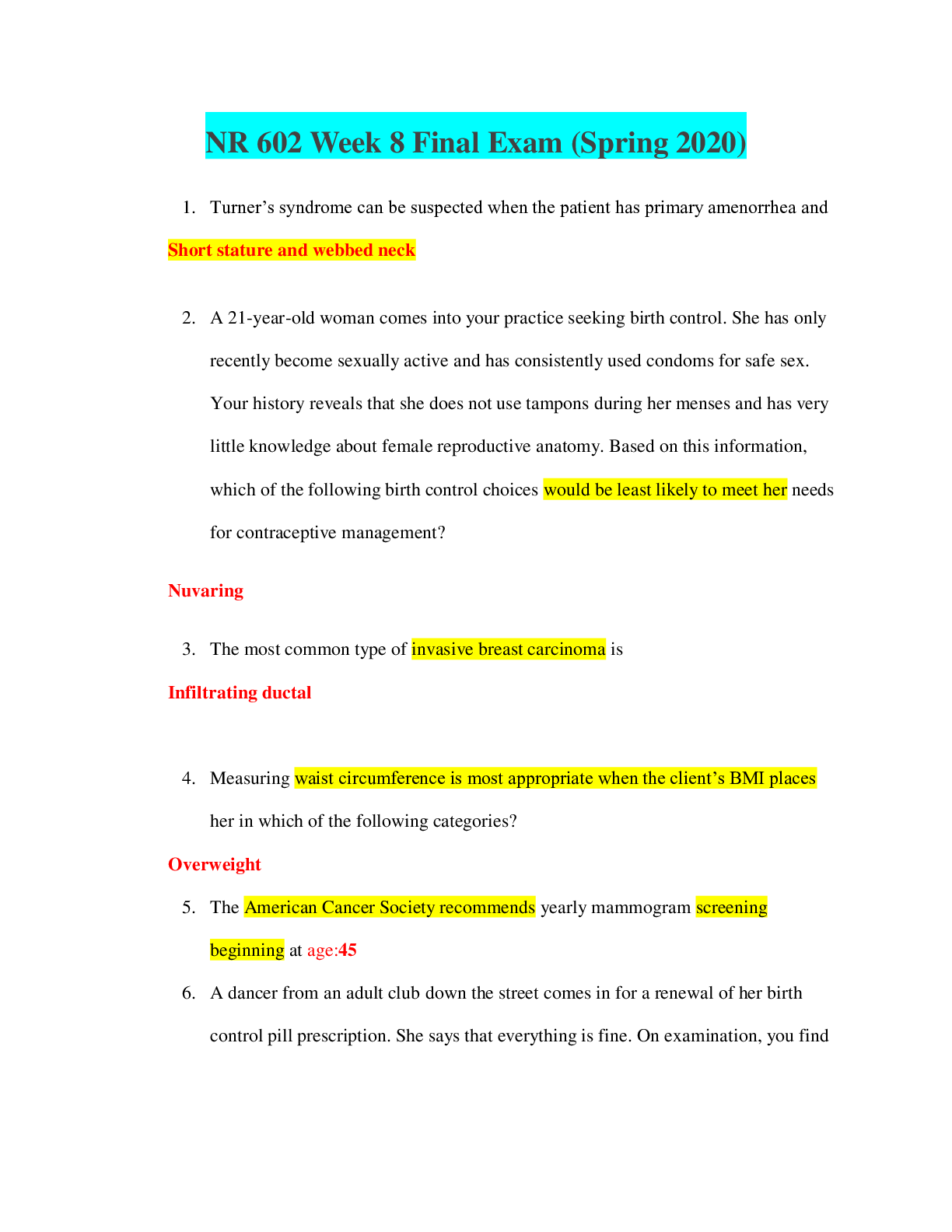*NURSING > EXAM > Chamberlain College of Nursing - NR 602 Week 7 Quiz Topics Questions with Answers (New) Nailed Grade (All)
Chamberlain College of Nursing - NR 602 Week 7 Quiz Topics Questions with Answers (New) Nailed Grade A
Document Content and Description Below
NR 602 Week 7 Quiz Topics Questions with Answers 1. Amenorrhea (Primary and secondary) • Abmormal uterine bleeding has multiple causes. When a women presents and reports menstrual irregularity w... ith amenorrhea , which is the most common cause of amenorrhea? • A teenage patient presents with amenorrhea and normal secondary sex characteristics. A progesterone challenge is ordered. The purpose is to determine the presence of • A nurse practitioner is caring for a woman with primary and secondary amenorrhea. The pelvic exam was normal. Which of the following may be the cause if etiology originates in the hypothalamus? • A 17-year-old female patient presents with amenorrhea for four months. She did experience menarche at the age of fifteen but had not had a menstrual cycle since. On physical examination, it is noted that she has normal secondary sexual characteristics. The nurse • Anna, aged twenty-five years, presents with dysmenorrhea. She states that her sister and her mother have endometriosis and she would like to be evaluated for it as well. Which if the following is consistent with a diagnosis of endometriosis? • You are completing a well visit on a 14 year-old female who is currently not menstruating. Primary amenorrhea is best described as ________. • A progesterone challenge is ordered. The purpose is to determine the presence of • The pituitary gland is responsible for a variety of functions with respect to hormonal regulation and is composed of two lobes, the anterior and posterior sections. Which of the following list of hormones are secreted by the anterior pituitary gland • A nurse practitioner is educating a patient who has just been diagnosed with polycystic ovary syndrome (PCOS). She needs to be aware that PCOS is associated with which of the following clinical manifestations? • A patient is coming to the clinic for a follow-up of some diagnostic testing that she had done. When you review the chart, you find that she now has findings consistent with a diagnosis of polycystic ovary syndrome (PCOS).You recall that PCOS is characterized by which of the following? • A sixty-year-old woman has presented with the chief complaint of bleeding after intercourse. Which of the following is not associated with postcoital bleeding or spotting in a postmenopausal woman? • A 16 year-old female is diagnosed with primary dysmenorrhea. She has taken over the counter ibuprofen in 800 mg increments every 8 hours during menses for the past 3 months with minimal relief of symptoms. What intervention will provide greatest relief of dysmenorrhea symptoms? • A 22-year-old woman in the endocrine clinic is evaluated for amenorrhea, acne, and excessive hair growth. She states that this is not a new problem but as she has gotten older, the changes have disturbed her more. You do a full hormonal evaluation and diagnose her with adrenal hyperplasia for which you prescribe prednisone (a glucocorticoid). On treatment, she is most likely to see an improvement in which of the following? • Surgical removal of a unilateral Sertoli-Leydig cell tumor should result in the reversal of which of the following symptoms? 2. Dysmenorrhea (ENDOMETRIOSIS) • Anna, aged 25 years, presents with dysmenorrhea. She states that her sister and her mother have endometriosis and she would like to be evaluated for it as well. Which if the following is consistent with a diagnosis of endometriosis? • The first line treatment of severe menstrual cramps that have been occurring for four months in a patient with primary dysmenorrhea includes which of the following? • A patient who a nurse practitioner is seeing for the first time has the past medical history of primary dysmenorrhea. She recalls that which of the following is considered as the primary etiology? • Lauren, twenty-three years old, presents to your office with a complaint of severe menstrual cramps for four months since she quit using an oral contraceptive. Your tentative diagnosis is primary dysmenorrhea. What would be the first-line treatment for this condition? • The most common cause of chronic pelvic pain for women in their reproductive years is • A twenty-five-year-old patient presents with irregular bleeding after being on oral contraceptives for six months. It is important to rule out which of the following? • A nurse practitioner is teaching an undergraduate pathophysiology class about changes associated with puberty. Which of the following is an inaccurate point that should not be included? • What percent of women with endometriosis have ovarian involvement? • According to the American Fertility Society classification of endometriosis, a patient with complete obliteration of the cul-de-sac by adhesions has • Sampson's theory of the development of endometriosis is based on the occurrence of • Which of the following statements about the uterosacral nodularity associated with endometriosis is correct? • The diagnosis of endometriosis is best confirmed on the basis of • Which of the following best describes the dysmenorrhea associated with endometriosis? • Magnetic resonance imaging is most useful in detecting • About what percent of women undergoing laparoscopy for infertility are found to have endometriosis? • Constitutional hirsutism is typically treated by administration of • A 28-year-old patient is diagnosed with PCOS and is given oral contraceptive pills to improve her symptoms. This treatment is intended to improve her symptoms through • Polycystic ovarian syndrome can be viewed as a disorder involving • Menorrhagia associated with uterine leiomyoma is defined as menstrual blood loss of greater than • A 32-year-old nulligravid woman is seen in your office for her annual visit. On examination, she has hair growth on her nipples and lower abdomen and some temporal thinning of her hair. Blood tests indicate a high-normal level of free and total testosterone. The most likely cause of her hirsutism is • A 25-year-old woman presents with an inability to conceive for 9 months. She has irregular menstrual cycles that occur every 1-3 months. She also reports a 20-pound weight gain (BMI = 32), worsening acne, fatigue, and dark hairs on her chin that she removes. Her most likely diagnosis is 3. STDs • A 25 -old female presents with vaginal irritation and discharge. On examination, the cervix is easily friable and erythematous. There is no adnexal tenderness. The wet prep microscopic examination reveals mobile protozoa on the normal saline slide. This most likely represents _________. • A 24 -year-old female presents to the office with a complaint of vaginal itching in addition to thick mucoid discharge. She also has some mild urinary discomfort. A wet mount preparation using potassium hydroxide (KOH) reveals a negative whiff test and few clue cells. There were no trichomonads visualized but the WBCs were too numerous to count. Which of the following would be the most likely diagnosis in this patient? • A school nurse is reviewing a female student’s records regarding presence of the human papillomavirus vaccine (HPV). Which of the following statements most clearly represents the current guidelines with respect to immunization against HPV? • The highest prevalence of human papillomavirus (HPV) is found among women ages: • Which of the following is caused by an anaerobic one-celled protozoan that commonly lives in the vagina? • Who should be screened regularly for STIs? • Which one of the following statements about sexually transmitted infections (STIs) is false? • Patient education for condylomata acuminata should include all the following except: • Which of the following is not true for HIV infection evaluation? • Karen was recently diagnosed with primary syphilis by her primary care provider, she is very upset and inquires how long after sexual contact do syphilis symptoms typically occur. What is the correct response by the primary care provider? • The nurse practitioner student is studying the CDC guidelines for treating sexually transmitted infections. Which of the following agents is recommended for Gonorrhea treatment? • A 22 year -old female presents with an initial onset of herpes simplex on the external genitalia. During the patient education, which of the following statements is most important to include? • Karen was recently diagnosed with primary syphilis. The nurse practitioner understands that the first-line treatment option for primary syphilis include: • Elizabeth was evaluated and diagnosed with a primary outbreak of genital herpes in the clinic today. The treatment plan for Elizabeth will include a prescription for: • Karen was diagnosed with trichomoniasis by her primary care provider and treated with: • Which of the following terms describe the mechanism of action of Imiquimod (Aldara) in the management of genital warts? • A 65-year-old obese female with type II diabetes mellitus presents to your office with a complaint of vaginal itching and burning for two weeks. She has not been sexually active for five years. She has tried douching with an OTC cream with no relief. On physical examination, the vulva is deep red with some thick white adherent material. Which of the following conditions would be the most likely cause of her symptoms? • Your female patient presents for vaginal discharge with an odor, and has noticed painless “bumps” on her vaginal area. Sexual history includes past male partners and her current female partner. On exam you note beefy red papules and an ulcerative lesion on her vulva, granular tissue and scarring, and inguinal adenopathy. You suspect she has: • Tina is evaluated and diagnosed with Molluscum Contagiosum. The nurse practitioner understands that clinical presentation of this disease is characterized by: • Misty presents with a painful “sores” in her perineal area, dysuria and dyspareunia. On exam she has 2 shallow ulcerated lesions on the right labia majora and one on the left. She also presents with enlarged inguinal lymph nodes. Based on these findings you suspect she has: • Cindy presents to your clinic for STI testing after realizing her current boyfriend has been seeing other women. She states she was told that one of the women has hepatitis B. Your patient education regarding hepatitis B includes all the following except: • Stacy has made an appointment at your clinic for c/o dysuria. During the HPI she explains, “My bottom hurts when I pee, and I have bumps there”. She has never had this before and is worried. She denies fever, although she feels “a little like I have the flu” explaining she has a headache and feels achy and tired. She denies exposure to a STI noting she and her partner have been monogamous for 6 years. On exam you notice a cluster of painful vesicles adjacent to the vaginal introitus. The most likely diagnosis is: • You see an 18-year-old woman with a history of Chlamydia infection and a total of five lifetime partners. Based on the latest evidence-based guidelines, you recommend: • While educating Karen about the different stages of syphilis, which of the following is not representative of the presentation of secondary syphilis? • The nurse practitioner understands that HPV types _____ and ____are most often associated with cervical and anogenital cancer. • Jenna was evaluated and diagnosed with condyloma acuminatum. Treatment options for Jenna will include all of the following except: • Which of the following is a treatment option for a 30-year-old woman with PID and a history of severe hive-form reaction when taking a penicillin or cephalosporin? • The nurse practitioner understands that a complication of gonoccocal and chlamydial genitourinary infection in women include which of the following: • A nurse practitioner is performing a wet mount with potassium hydroxide (KOH) to assist with a diagnosis in a woman experiencing vaginal discharge. Which of the following would this confirm? • The nurse practitioner understands that women with PID typically present with all of the following except: • Elizabeth was recently diagnosed with genital herpes after having unprotected intercourse with a new partner. The nurse practitioner explains to Christine that the incubation period for HSV Type 2 is approximately: • Kristin returns to the clinic for follow-up on STI results. The nurse practitioner informs her the Chlamydia test was positive. Which of the following agents will the nurse practitioner prescribe for treatment? • A 30-year-old woman presents without symptoms but states that her male partner has dysuria without penile discharge. Examination of the woman reveals a friable cervix with yellow discharge from the cervical os. This description is most consistent with an infection caused by: Select all that apply. • A 24-year-old woman presents with a 1-week history of thin, greenish yellow vaginal discharge with perivaginal irritation. Physical examination findings include vaginal erythema with petechial hemorrhages on the cervix, numerous white blood cells, and motile organisms on microscopic examination. These findings most likely represent: • For patients needing topical treatment for vulvovaginitis caused by Candida albicans, the nurse practitioner will prescribe: • The nurse practitioner understands that women with bacterial vaginosis typically present with: • An important part of patient education for the patient with bacterial vaginosis who is receiving a prescription for oral Metronidazole is: • For the patient with chronic bacterial vaginosis, the nurse practitioner will prescribe: • The nurse practitioner's exam findings on a patient with vaginal Candidiasis is positive for all of the following except: • Whether you order diagnostic testing or refer the patient to an HIV-specific facility, laboratory confirmation is rendered. The test confirming HIV infection is _____________. • The nurse practitioner is examining a twenty-nine-year-old female with a 3-day history of dysuria and urinary frequency. On examination, the patient is positive for suprapubic tenderness and negative for costovertebral angle (CVA) tenderness. This most likely represents which of the following? • A patient has been diagnosed with trichomoniasis. Which of the following single dose medications would be the best option? • A 39-year-old female has just completed a course of Amoxicillin for the treatment of streptococcal pharyngitis. Her LMP was two weeks ago and reports that it was normal for her. On physical examination, there is some erythema of the external genitalia with a small amount of white discharge. The microscopic wet prep examination reveals few clue cells but an abundance of budding hyphae. There are no WBCs present. Considering the differential diagnoses and results of the microscopic examination, which of the following would be the most appropriate treatment? • A 25-year-old female presents with vaginal irritation and discharge. On examination, the cervix is easily friable and erythematous. There is no adnexal tenderness. The wet prep (wet mount) microscopic examination reveals mobile protozoa on the normal saline slide. This most likely represents _________. • Sheryl, a 17 year-old, complains of a vaginal discharge for the past month. When she wipes after urinating, there is "white stuff" on the tissue. Sheryl denies urinary problems but has had some genital itching, but no odor. She also denies sexual activity. Her vaginal discharge is most likely a result of ______. • A 25-year-old woman comes to the clinic complaining of increased vaginal discharge, milky gray in color with a "fishy" odor that both she and her husband have noticed. A wet smear is performed and the presence of "clue cells" confirmed. Which type of infection does the nurse suspect? • A woman visits the clinic for an annual physical examination, and herpes genitalis is diagnosed. The client asks how the disease can be diagnosed without any tests. How should the nurse reply? • A female client who has been sexually active for 5 years is found to have gonorrhea. The client is upset and asks the nurse, "What can I do to keep from getting another infection in the future?" Which statement by the client indicates that the teaching by the nurse was effective? • A 16-year-old client has a steady boyfriend with whom she is having sexual relations. She asks the nurse how she can protect herself from contracting HIV. What should the nurse advise her to do? • A 21-year-old female presents with three 0.5 cm human papilloma virus (HPV) lesions on her vulva. An appropriate treatment option for this patient would be: • All of the following are infections that affect mostly the labia and vagina except: [Show More]
Last updated: 1 year ago
Preview 1 out of 6 pages
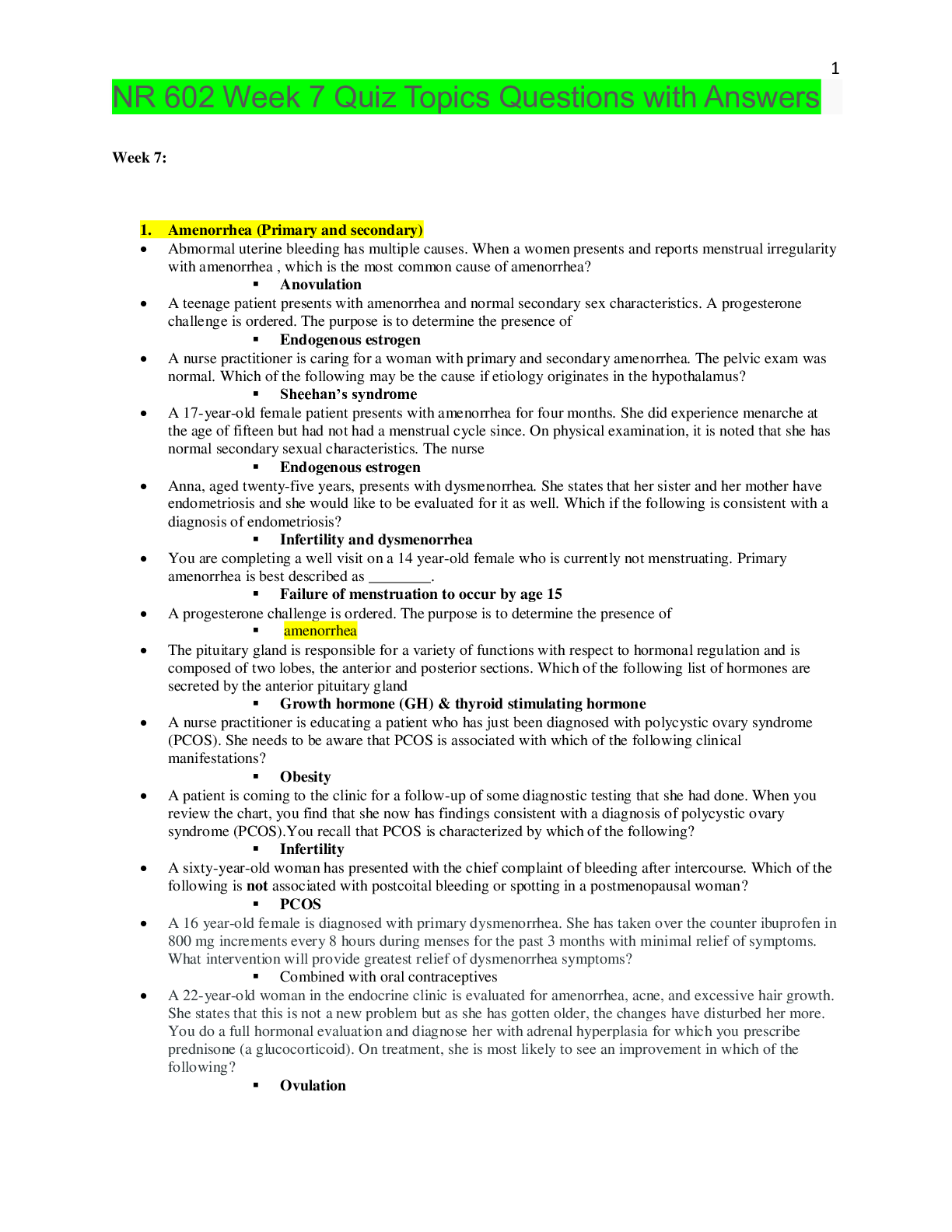
Reviews( 0 )
Document information
Connected school, study & course
About the document
Uploaded On
Oct 26, 2019
Number of pages
6
Written in
Additional information
This document has been written for:
Uploaded
Oct 26, 2019
Downloads
0
Views
61

